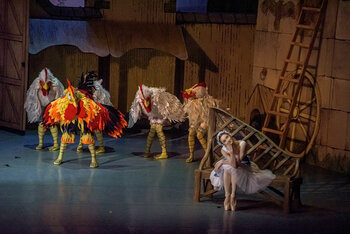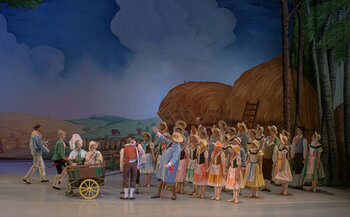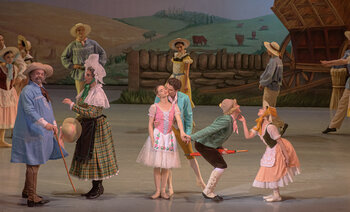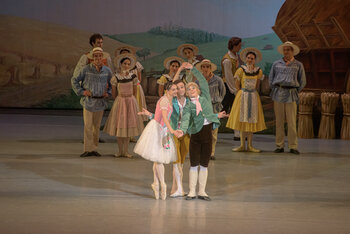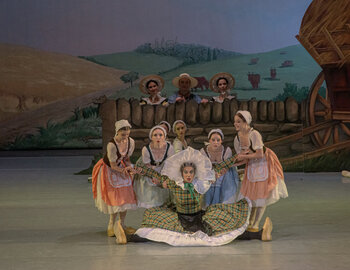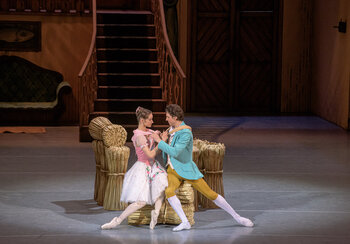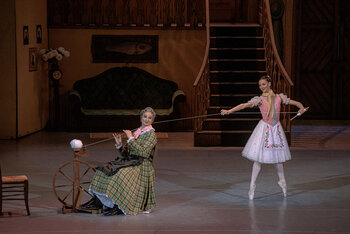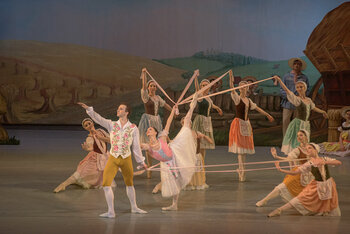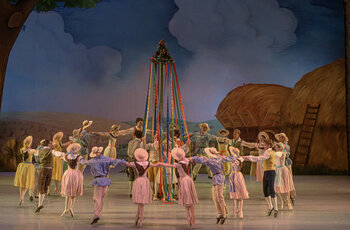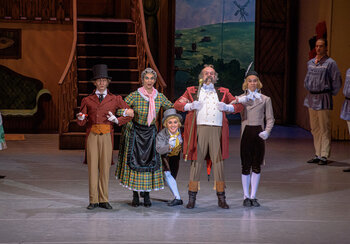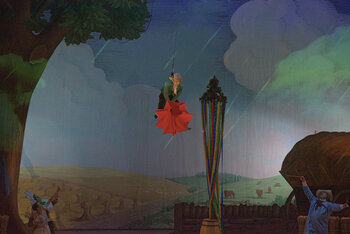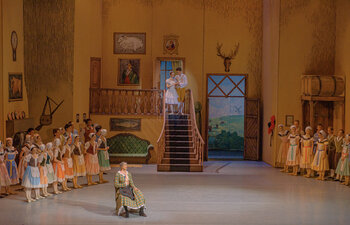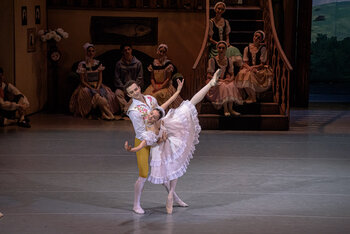Upcoming shows
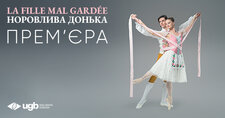
Music arrangement John Lanchbery
Set and costume design Sir Osbert Lancaster
The performance was created with full financial support and organisation by
Synopsis
Lise, the only daughter of Simone who is a widow and owner of a prosperous farm, is in love with Colas, a young farmer, but her mother has far more ambitious plans.
Act І
The dawn of a busy day on the farm is heralded by the cock and his attendant hens. Lise, disappointed at not seeing Colas, leaves a ribbon tied in a lover's knot as a token of her devotion.
Colas finds it and binds it to his staff. The lovers meet, but are interrupted by Simone, who sets her daughter a task churning butter. Colas, hiding in the loft, joins her. The work is shared and then forgotten as they declare their love.
The farm girls summon Lise to play, but her mind is elsewhere. Her suspicious and ever-watchful mother catches hold of her and chastizes her. Just then Thomas, the pompous and wealthy proprietor of a vineyard, arrives with his son Alain. Simone, aware of their mission, dismisses Lise, and Thomas asks her hand for his son. When Lise returns, Alain coyly and clumsily shows off his paces. She is amused and a little shocked by his antics, but not interested.
They set off for the harvest.
Act ІІ
After working in the fields the harvesters, led by Colas, relax in a joyful dance. Lise and Alain dance, but Colas intervenes, and the young girl makes it clear where her preference lies. One of the harvesters plays the flute, to everybody's general delight, and Alain thinks he will have a try; but the harvesters mock him and he is rescued from their horseplay by his indignant father.
The field is now left clear for the triumphant Colas, who dances with Lise. Simone joins in the merriment of the harvesters. Suddenly they are interrupted by a storm that drenches them, scattering them far and wide.
Act ІІІ
Mother and daughter, soaked by the storm, return to the farmhouse. They sit down to spin; work, thinks the mother, should keep Lise out of mischief. But she is overcome by sleep, and Lise, who has seen Colas through the gate, tries to take the key from her. Simone wakes and, in order to remain watchful, plays the tambourine for Lise to dance. But the taps grow feebler, she begins to nod, and now she is fast asleep.
Lise runs joyfully into Colas’ arms. The knocking of the harvesters, coming for their pay, awakens Simone. Simone tells her daughter to get on with her chores as she leaves to give the harvesters a drink. Lise, thinking she is alone, dreams of the delights of married life. Colas cannot resist, and comes out from hiding. She is bashful at having been taken by surprise, but once again they declare their love.
As Simone reappears, Lise hustles Colas into her bedroom. The ever-suspicious mother realizes that the lovers have been meeting, and in her turn hustles Lise into the bedroom, locking the door.
Alain and his father now arrive with a notary to complete the contract. When it has been signed, Simone hands Alain the bedroom key. After a moment of idiotic indecision, he opens the door and to everyone's dismay Colas and Lise come out. The lovers fall on their knees to ask Simone for forgiveness and a blessing. In spite of Thomas and Alain, she finally gives in amid general rejoicing.
ASHTON’S WAYWARD DAUGHTER
Frederick Ashton would have been delighted that his undisputed masterpiece, La Fille mal gardée (1960) was finally finding a new home in Ukraine, a land of stubborn heroes much admired by the British, who have their own long history of resisting tyranny. The original ballet premiered in Bordeaux in 1789 had productions in Paris and London very soon after. Ashton was inspired to create a new version of Fille, by the famous section of mime known as When I Am Married, which had possibly survived from Dauberval’s 1789 original. When I see ballerinas rehearsing this beautiful episode, I am often touched by the intensity and clarity of the simple gestures movingly conveying the fervent hopes of a young woman in love.
When Ashton died in 1988, he left the important ballets to his closest friends in his legal testament. Alexander Grant, the outstanding demi-caractère dancer who had created the role of Alain, was bequeathed La Fille mal gardée, and I was privileged to watch him rehearse the ballet at the Paris Opéra and in Budapest in the years before his death in 2011. Grant, in turn, left the choreographic rights to his partner of many years, Jean-Pierre Gasquet, who recently celebrated his 90th birthday. It is thanks to the great generosity of Mr Gasquet, who has freely donated the ballet to the National Ballet of Ukraine, that Fille will now bring happiness to all who witness its powerful magic. The great dancer Ivan Putrov has been the prime mover in securing Fille for the Ukrainian people and he and Mr Gasquet have proved to be a strong and determined partnership.
As Fille is a highly complex work, imposing the best stager/repetiteur is crucial. In recent years this has always been Jean-Christophe Lesage, a ballet master of vast experience, constantly in demand, who teaches quickly, accurately and whose natural charm and intelligence make the whole process of learning the choreography a pleasure. Over the last decade the ballet has had productions in Birmingham, Bordeaux, Bratislava, Bucharest, Budapest, London, New York, Prague, Riga, Rome, Stuttgart, Sarasota, Seoul, Tokyo, Vienna and Vilnius.
Dancers new to Ashton’s work often find the physical demands very tough. The Ashton, or English, style is based on fast, precise footwork; an emphasis on epaulement; a highly articulated torso, with deep bends to the side and back; and the use of the head and eyes as important elements of expression. In other words, there is no part of the body which is not engaged in iterating the choreography. It is frequently exhausting to dance. However, it is interesting to observe how dancers always develop a real love for the choreography after a few weeks. La Fille mal gardée is a difficult ballet to cast. Lise, Colas and Alain are demi-caractère roles, so pale sylphs and skinny romantic princes are not required. Young dancers with strong personalities and bravura techniques are ideal.
Drawing the myriad elements of Fille together is a complicated task. The ballet is like an intricate piece of clockwork created on Aristotelian rules of theatre, commencing at dawn and ending at sunset. The comedy is always on the downbeat of the music, but so are many romantic moments, like the scene where Colas plants eight kisses on Lise’s arms to a matching eight downbeats in the score. Done perfectly, this scene can make you weep. Ashton himself said that this moment was the beating heart of the ballet. I was privileged to hear so much about Fille during hundreds of hours of conversation with the choreographer. Because it is a romantic comedy it is easy to think of Fille as a joyful soufflé, but choreographically it is one of the most technically demanding ballets ever made. Yes, it is a feelgood piece, everyone leaves the theatre happy after a life-enhancing experience, and audiences and critics love it. They don’t always understand it; or appreciate the intensely detailed thinking that has gone into making this charming work a sure-fire masterpiece. As Ashton once laughingly said to me: “If it’s a soufflé, it's one with iron sinews.”
It has been a pleasure to work as part of a team headed by Jean-Pierre Gasquet, a man of great wisdom and encyclopaedic knowledge who knows this ballet so well; with the unperturbable Jean-Christophe Lesage; and the indefatigable Ivan Putrov, whose determination to get Fille onto the stage in Kyiv has brooked no obstacles. To these men Ukraine owes a great debt of gratitude.
- Ilona KRAVCHENKO
- Daniil SILKIN
- Andrii BONDARCHUK
- Svitlana KOVTUN
- Nataliia IAKYMCHUK
- Kateryna DIDENKO
- Kateryna CHUPINA
- Viktor OLIYNYK
- Mykyta SUKHORUKOV
- Sergii LYTVYNENKO
- Ernest KYRSENKO
- Kareryna KRUK
- Kateryna DEGTIAROVA
- Diana IVANCHENKO
- Andrianna SHABAIEVA
- Oleksandr GABELKO
- Clement GUILLAUME
- Ernest KYRSENKO
- ХІДЖІКАТА Аяме
- Anna IELISIEIEVA
- Mariia KIRSANOVA
- ФІЛОНЕНКО Дар’я

